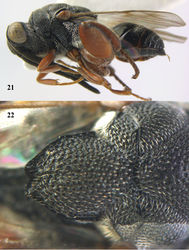Antrocephalus sepyra
| Notice: | This page is derived from the original publication listed below, whose author(s) should always be credited. Further contributors may edit and improve the content of this page and, consequently, need to be credited as well (see page history). Any assessment of factual correctness requires a careful review of the original article as well as of subsequent contributions.
If you are uncertain whether your planned contribution is correct or not, we suggest that you use the associated discussion page instead of editing the page directly. This page should be cited as follows (rationale):
Citation formats to copy and paste
BibTeX: @article{Narendran2016ZooKeys, RIS/ Endnote: TY - JOUR Wikipedia/ Citizendium: <ref name="Narendran2016ZooKeys">{{Citation See also the citation download page at the journal. |
Ordo: Hymenoptera
Familia: Chalcididae
Genus: Antrocephalus
Name
Antrocephalus sepyra (Walker, 1846) – Wikispecies link – Pensoft Profile
- Halticella sepyra Walker, 1846: 110 (India (lectotype selected by Bouček) (HDOU) (examined); synonymy by Narendran (1989)[1] with Antrocephalus dividens (Walker)).
- Chalcis dividens Walker, 1860: 357 (♀ Sri Lanka (BMNH) examined); junior synonym of Halticella sepyra Walker.
- Halticella apicalis Walker, 1874: 400. (♀, Japan (BMNH) (examined); synonymy by Narendran (1989)[1] with Antrocephalus dividens (Walker)).
- [[Halticella
(Stomatoceras) tinctipennis|Halticella (Stomatoceras) tinctipennis]] Cameron, 1888: 118 (Japan (BMNH) (examined); synonymy by Habu (1960)[2] with Antrocephalus apicalis (Walker)).
- Coelochalcis carinifrons Cameron, 1904: 111 (♂, India, Sikkim (BMNH) (examined); synonymy by Narendran (1989[1] with Antrocephalus dividens (Walker)).
- Antrocephalus varipilosus Cameron, 1907: 580 (♂, India, Gujarat, Dredra (BMNH) examined; synonymy by Narendran (1989)[1] with Antrocephalus dividens (Walker)).
- Sabatiella nepalensis Mani & Dubey (in Mani et al.), 1974[3]: 21 (♀, Nepal, Kathmandu (USNM) (examined); synonymy by Narendran (1989)[1] with Antrocephalus dividens (Walker)).
- Antrocephalus delhiatus Roy & Farooqi, 1984: 9 (♀, India, Delhi (INPC) (examined); synonymy by Narendran (1989)[1] with Antrocephalus dividens (Walker)).
Material
(RMNH, IEBR, labelled as Antrocephalus dividens, Antrocephalus fascicornis or Antrocephalus japonicus by first author). 4 ♀ + 7 ♂, “Vietnam: Ninh Thuân, Núi Chúa N. P., northeast part, Malaise trap, 90–150 m, 23–30.v.2007, C. v. Achterberg & R. de Vries, RMNH’07”; 1 ♀ + 1 ♂, “S. Vietnam: Dóng Nai, Cát Tiên N. P., c 100 m, 13–20.v.2007, Botanical Garden, Malaise traps 14–19, C. v. Achterberg & R. de Vries, RMNH’07”; 2 ♀ + 1 ♂, id., but 14–20.v.2007, Malaise traps 20–23, Lagerstroemia trail; 1 ♀, id., but 9–30.iv.2007, Ficus trail; 1 ♀, id., but Dong trail, 9. iv.–9.v.2007, M.P. Quy, N.T. Manh & C. v. Achterberg, RMNH’07; 1 ♂, id., but 13–19.v.2007; 1 ♂, id., but 19–25.iv.2007; 2 ♂, id., but 1–8.iv.2007, Mai Phu Quy & Nguyen Tanh Manh; 1 ♀, “S. Vietnam: Dak Lak, Chu Yang Sin N. P., near dam, c. 500 m, 3–9.vi.2007 & 1–10.vi.2007, Malaise trap, C. v. Achterberg & R. de Vries, RMNH’07”; 1 ♂, id., but near river, c. 740 m, 1–10.vi.2007; 1 ♂, id., but Krong K’Mar, 740–900 m, 2–10.vi.2007; 1 ♂ (RMNH), “C. Vietnam: Ha Tinh, Vu Quang N. P., 111 m, , 18°19'40”N 105°26'29”E, 23.ix.-5.x.2009, Mal[aise] trap 23, C. v. Achterberg & R. de Vries, RMNH’09”; 1 ♂ (RMNH), “C. Vietnam: Ha Tinh, Vu Quang N. P., 1.x.2009, by hand, R. de Vries, RMNH’09”.
Diagnosis
Antrocephalus sepyra (Walker) comes very near Antrocephalus fascicornis (Walker) in general appearance such as colour and sculpture on mesosoma. However, Antrocephalus fascicornis differs from Antrocephalus sepyra in having: 1) hind femur with a long row of comb teeth occupying a trifle shorter than three-fourth of outer ventral margin from apex to base (in Antrocephalus sepyra the length of row of comb teeth is shorter); and 2) head in profile with a sharp angle in front of eyes. (in Antrocephalus sepyra no such sharp angle in front of eyes in profile).
Description
♀, length of body 4.0–5.5 mm.
Colour. Head black; eyes pale yellow or pale yellowish gray or black; tegula reddish brown or pale yellowish brown; all legs except black fore coxa ferruginous red; metasoma black; pedicel, ring segment and F1 pale in some specimens.
Head. Scape not reaching anterior ocellus.
Mesosoma. Pronotum with anterior carinae and tubercles; apex of scutellum weakly emarginated.
Legs. Hind coxa without a tooth dorsally; hind femur without an inner basal tooth.
Metasoma. Metasoma about as long as combined length of head and mesosoma. T1 smooth and shiny with a pair of short basal carinae.
Male. Antenna longer than that of ♀; metasoma shorter than head plus mesosoma.
Variation
Colour of hind tibia varies from reddish brown to black (except apically) as emargination of apex of scutellum. Colour of hind femur is black with base and apex reddish brown and pedicel to F5 reddish brown in one specimen (labelled as “Antrocephalus japonicus”).
Host
Unknown.
Distribution
India, Nepal, Sri Lanka, Japan, Vietnam (new record).
Taxon Treatment
- Narendran, T; van Achterberg, C; 2016: Revision of the family Chalcididae (Hymenoptera, Chalcidoidea) from Vietnam, with the description of 13 new species ZooKeys, (576): 1-202. doi
Images
|
Other References
- ↑ 1.0 1.1 1.2 1.3 1.4 1.5 Narendran T (1989) Oriental Chalcididae (Hymenoptera: Chalcidoidea). Zoological Monograph. Department of Zoology, University of Calicut, Kerala, 1–441.
- ↑ Habu A (1960) A revision of the Chalcididae (Hymenoptera) of Japan with description of sixteen new species. Bulletin of National Institute of Agricultural Sciences, Tokyo (C) 11: 131–363.
- ↑ Mani M, Dubey O, Kaul B, Saraswat G (1974) Descriptions of some new and new records of some known Chalcidoidea (Hymenoptera) from India. Memoirs of the School of Entomology, St. John’s College, Agra No. 3: 1–108.
